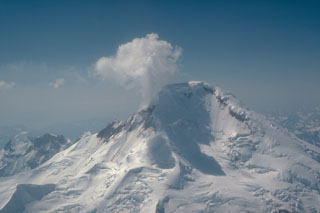Report on Iliamna (United States) — 25 June-1 July 2025
Smithsonian Institution / US Geological Survey
Weekly Volcanic Activity Report, 25 June-1 July 2025
Managing Editor: Sally Sennert.
Please cite this report as:
Global Volcanism Program, 2025. Report on Iliamna (United States) (Sennert, S, ed.). Weekly Volcanic Activity Report, 25 June-1 July 2025. Smithsonian Institution and US Geological Survey.
Iliamna
United States
60.032°N, 153.09°W; summit elev. 3053 m
All times are local (unless otherwise noted)
The Alaska Volcano Observatory (AVO) reported that repairs to Iliamna’s seismic network were completed during the previous week, allowing for sufficient data to be available to monitor activity. At 1141 on 1 July the Aviation Color Code was changed from Unassigned to Green (the lowest level on a four-color scale) and the Volcano Alert Level was changed from Unassigned to Normal (the lowest level on a four-level scale).
Geological Summary. Iliamna is a prominentglacier-covered stratovolcano in Lake Clark National Park on the western side of Cook Inlet, about 225 km SW of Anchorage. Its flat-topped summit is flanked on the south, along a 5-km-long ridge, by the prominent North and South Twin Peaks, satellitic lava dome complexes. The Johnson Glacier dome complex lies on the NE flank. Steep headwalls on the S and E flanks expose an inaccessible cross-section of the volcano. Major glaciers radiate from the summit, and valleys below the summit contain debris-avalanche and lahar deposits. Only a few major Holocene explosive eruptions have occurred from the deeply dissected volcano, which lacks a distinct crater. Most of the reports of historical eruptions may represent plumes from vigorous fumaroles E and SE of the summit, which are often mistaken for eruption columns (Miller et al., 1998). Eruptions producing pyroclastic flows have been dated at as recent as about 300 and 140 years ago, and elevated seismicity accompanying dike emplacement beneath the volcano was recorded in 1996.
Source: US Geological Survey Alaska Volcano Observatory (AVO)

